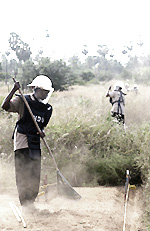
14/11/2006 - Al Jazeera (www.english.aljazeera.net) The explosive remnants of war |
|||||
| By Jonathan Gorvett in Colombo | |||||
 |
|||||
Sri Lanka 's landmines are exacting an increasing civilian toll |
|||||
After nearly 25 years of fighting it is unclear exactly how many landmines are now scattered across the Sri Lankan countryside or Estimates vary between half-a-million and a million-and-a-half, and since fighting intensified in August these mines have been joined by scores of unexploded bombs, rockets, grenades and shells. These legacies of conflict are known collectively as ERW - the explosive remnants of war. Last week, near Batticaloa, seven people, including four children, were seriously injured by some of this ERW when an 81mm mortar round one of the children was playing with exploded. The wounded were not combatants, nor members of any army. A Imthiaz Ismail, the head of the local mine clearance group at the Milinda Moragoda Institute (MMI), said: "With mines, long after the war is over, civilians are being crippled and killed by them and deprived of their ability to lead a normal life." Operating under the umbrella of Sri Lanka's National Steering Committee for Mine Action, mine clearance groups from a variety of countries are working both in government areas and those under the control of the Tamil Tigers. MMI has been able to transcend the conflict's divisions thanks to its policy of recruiting mine-clearers from every ethnicity, religion and community. "With de-miners from different areas and groups working together," said M Barun, a Muslim from Vavuniya, a mainly Tamil town in the north, currently controlled by the government. "We have all leant about the other religions and geographical locations and customs. Even the way common words are pronounced." |
|||||
|
|||||
| E Wigeyaratnam, another mine clearer who is a Hindu Tamil, said: "It is an act of great merit to help people return to their homes." Armed only with protective gear and a two-metre adapted gardening rake, Wigeyaratnam set off trawling the topsoil. His closest companion is 20 metres away, also advancing slowly forwards, raking the booby-trapped earth. He has a two-metre-wide lane to clear along what is called a "base line" extending into the suspected area, off which one-metre-wide "start lanes" will then be excavated, extending from the edge of the minefield right into its heart. |
|||||
| The mines the clearers find are usually relatively unsophisticated, with many of them - known as "Johnnys" - just home-made wooden boxes with a couple of AA batteries, a detonator and some explosive. Sutherland said: "On average, NPA-HDU de-miners remove 538 AP mines per month in the non-government-controlled areas of the Vanni, sometimes more, sometimes less. |
|
||||
| At a recent end of work cycle destruction of mines we burnt 533 AP mines between 10.11am and 12.41am. "But it's not really just about how many mines you take out of the ground. It's about releasing the land that you've cleared back into use." This is a point about which all the mine clearers agree - that what they are doing goes far beyond disposing of the devices themselves. "Now, before we start clearing, we do a survey of all the people who lived there, asking them if they would go back or not. Clearance becomes part of overall development plans." Yet now, after the failure of recent peace talks, the mine-clearers are working in the centre of a renewed conflict. However, Sutherland said: "This hasn't really impacted on morale. On the contrary, so long as people keep up their commitment to the de-mining, it stops them getting sucked into the conflict. We give them a job and a wage and that helps them stay out of it." Ismail said: "There are allegations that both sides have started laying mines again, but nothing has been proved. I think there is a glimmer of hope in that both sides still say they are committed to the de-mining process." So, every morning, the de-miners continue to head out for the jungles and paddy fields, armed with their rakes and protective clothing. "We spend more time with the team than with our own families," said TK Krishnan, a Hindu Tamil. "We are like one big family." |
|||||

